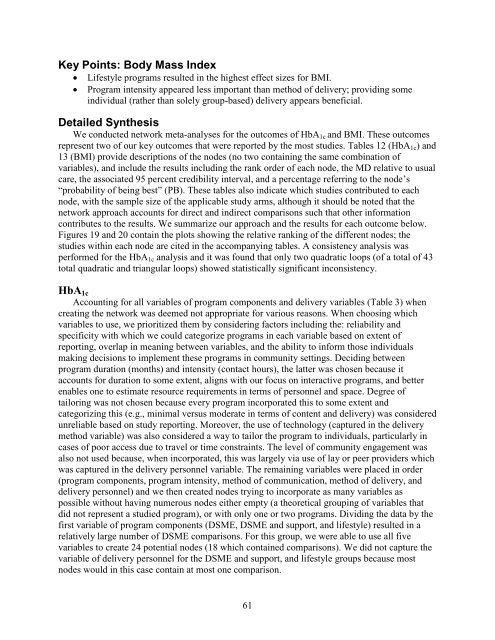Behavioral Programs for Diabetes Mellitus
diabetes-behavior-programs-report-150924
diabetes-behavior-programs-report-150924
- No tags were found...
You also want an ePaper? Increase the reach of your titles
YUMPU automatically turns print PDFs into web optimized ePapers that Google loves.
Key Points: Body Mass Index<br />
• Lifestyle programs resulted in the highest effect sizes <strong>for</strong> BMI.<br />
• Program intensity appeared less important than method of delivery; providing some<br />
individual (rather than solely group-based) delivery appears beneficial.<br />
Detailed Synthesis<br />
We conducted network meta-analyses <strong>for</strong> the outcomes of HbA 1c and BMI. These outcomes<br />
represent two of our key outcomes that were reported by the most studies. Tables 12 (HbA 1c ) and<br />
13 (BMI) provide descriptions of the nodes (no two containing the same combination of<br />
variables), and include the results including the rank order of each node, the MD relative to usual<br />
care, the associated 95 percent credibility interval, and a percentage referring to the node’s<br />
“probability of being best” (PB). These tables also indicate which studies contributed to each<br />
node, with the sample size of the applicable study arms, although it should be noted that the<br />
network approach accounts <strong>for</strong> direct and indirect comparisons such that other in<strong>for</strong>mation<br />
contributes to the results. We summarize our approach and the results <strong>for</strong> each outcome below.<br />
Figures 19 and 20 contain the plots showing the relative ranking of the different nodes; the<br />
studies within each node are cited in the accompanying tables. A consistency analysis was<br />
per<strong>for</strong>med <strong>for</strong> the HbA 1c analysis and it was found that only two quadratic loops (of a total of 43<br />
total quadratic and triangular loops) showed statistically significant inconsistency.<br />
HbA 1c<br />
Accounting <strong>for</strong> all variables of program components and delivery variables (Table 3) when<br />
creating the network was deemed not appropriate <strong>for</strong> various reasons. When choosing which<br />
variables to use, we prioritized them by considering factors including the: reliability and<br />
specificity with which we could categorize programs in each variable based on extent of<br />
reporting, overlap in meaning between variables, and the ability to in<strong>for</strong>m those individuals<br />
making decisions to implement these programs in community settings. Deciding between<br />
program duration (months) and intensity (contact hours), the latter was chosen because it<br />
accounts <strong>for</strong> duration to some extent, aligns with our focus on interactive programs, and better<br />
enables one to estimate resource requirements in terms of personnel and space. Degree of<br />
tailoring was not chosen because every program incorporated this to some extent and<br />
categorizing this (e.g., minimal versus moderate in terms of content and delivery) was considered<br />
unreliable based on study reporting. Moreover, the use of technology (captured in the delivery<br />
method variable) was also considered a way to tailor the program to individuals, particularly in<br />
cases of poor access due to travel or time constraints. The level of community engagement was<br />
also not used because, when incorporated, this was largely via use of lay or peer providers which<br />
was captured in the delivery personnel variable. The remaining variables were placed in order<br />
(program components, program intensity, method of communication, method of delivery, and<br />
delivery personnel) and we then created nodes trying to incorporate as many variables as<br />
possible without having numerous nodes either empty (a theoretical grouping of variables that<br />
did not represent a studied program), or with only one or two programs. Dividing the data by the<br />
first variable of program components (DSME, DSME and support, and lifestyle) resulted in a<br />
relatively large number of DSME comparisons. For this group, we were able to use all five<br />
variables to create 24 potential nodes (18 which contained comparisons). We did not capture the<br />
variable of delivery personnel <strong>for</strong> the DSME and support, and lifestyle groups because most<br />
nodes would in this case contain at most one comparison.<br />
61


